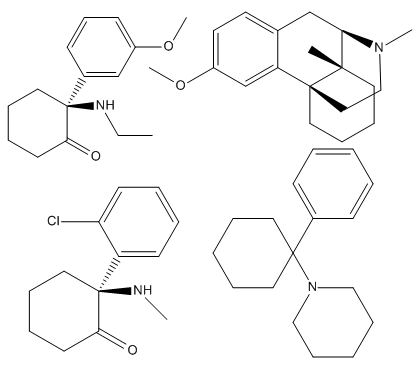Dissociatives

Dissociatives are a class of hallucinogen which distort perceptions of sight and sound and produce feelings of detachment and dissociation from the environment and self. This is done through reducing or blocking signals to the conscious mind from other parts of the brain.[1] Although many kinds of drugs are capable of such action, dissociatives are unique in that they do so in such a way that they produce hallucinogenic effects, which generally include sensory deprivation, dissociation, hallucinations, and dream-like states or trances.[2] Some, which are nonselective in action and affect the dopamine[3] and/or opioid[3] systems, may also be capable of inducing euphoria.
Mechanism of Action
NMDA receptors within the brain exist to allow for the transfer of electrical signals between neurons in the brain and in the spinal column. For electrical signals to pass, the NMDA receptor must be open. To remain open, the neurotransmitters known as glutamate and glycine must bind to the NMDA receptor. An NMDA receptor that has glycine and glutamate bound to it and has an open ion channel is called "activated." Dissociatives are NMDA receptor antagonists which means they bind to the receptor but do not activate it and block other neurotransmitters from doing so. The result is a dosage dependent decrease in the passing of electrical signals across the brain and a disconnection of neurones. This leads to states of disconnection between conscious parts of the brain and its sensory organs as well as out of body experiences and accompanying hallucinations.
Subjective effects
- Disconnection from tactile input
- Disconnection from visual input
- Disconnection from consciousness
- Detachment plateaus
- Time distortion
- Introspection
- Deja-Vu
- Removal of cultural filter
- Conceptual thinking
- Direct communication with the subconsious
- Ego suppression, loss and death
- States of unity and interconnectedness
Pharmacological Classes
Atypical
See Also
References
- ↑ PCP-induced alterations in cerebral glucose utilization in rat brain: blockade by metaphit, a PCP-receptor-acylating agent.| http://www.ncbi.nlm.nih.gov/pubmed/2850626
- ↑ Snyder, Solomon H. (1980). "Phencyclidine". Nature 285 (5764): 355–6. | http://www.nature.com/nature/journal/v285/n5764/abs/285355a0.html
- ↑ 3.0 3.1 Giannini, A. James; Nageotte, Catherine; Loiselle, Robert H.; Malone, Donald A.; Price, William A. (1984). "Comparison of Chlorpromazine, Haloperidol and Pimozide in the Treatment of Phencyclidine Psychosis: Da-2 Receptor Specificity". Clinical Toxicology 22 (6): 573–9. | http://www.ncbi.nlm.nih.gov/pubmed/6725621 Cite error: Invalid
<ref>tag; name "Giannini." defined multiple times with different content